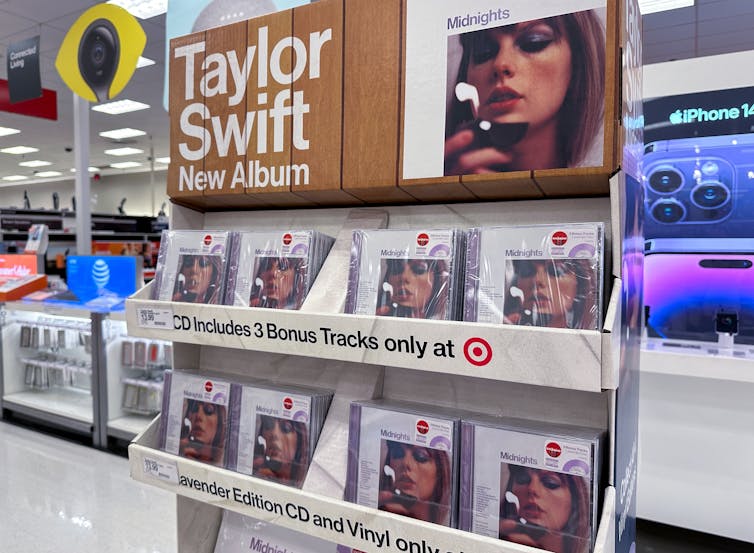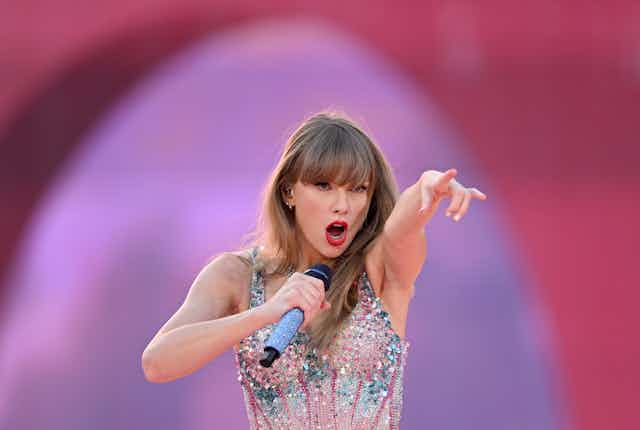There is no escaping Taylor Swift. Even if you try to ignore the star, she is currently everywhere. On the airwaves, on playlists, streaming services, social media, in the news, on the big screen and at a mega-stadium near you.
Devoted “Swifties” around the globe have their own lore, with the 34-year-old’s appeal crossing sex, age, class and cultural groups.
The largest US newspaper chain, Garnett, even appointed a dedicated Taylor Swift Reporter to cover her every move.
Arguably, we haven’t seen fan love (or media coverage) for a musical act on the scale of Taylor Swift since The Beatles.
What is it about her that drives unrelenting attention and adoration on such a grand scale? And could her current ubiquity actually turn out to be a threat?
Read more: Taylor Swift didn't just update the lyrics for Better Than Revenge – she updated her public image
What defines the Taylor Swift brand?
Swift’s talent as a songwriter, singer and performer cemented her as a multi-award winning artist . She has been nominated for 52 Grammys and won 14, and recently made history as the only artist to win Album of the Year four times.
She is both the girl next door and a mega-star with cross-generational appeal.
And she is also a global brand.
Almost anything (or anyone) can become a brand, with its own distinctive name, term, design or symbol. But a successful brand is more than an identity: it exists solidly in the public consciousness, like Nike, Apple and Google.
To occupy such a position, the keys to success for strong brands include: consistent messaging, differentiation and brand experience.
Read more: How did Taylor Swift get so popular? She never goes out of style
Taylor has crafted the all-American girl next door image by sharing consistent messaging about her personal experiences through her lyrics.
She also differentiates her brand from those of other artists by encouraging an organic fan community, complete with its own look and feel.
Fans wear album-themed colours or costumes and trade friendship bracelets.
The brand experience manifests through social media, surprise announcements, hidden “Easter eggs”, concert tours, and even the Eras Tour film. Fans are never short of an opportunity to connect with the star.

The most successful brands form an emotional connection with consumers.
In this regard, Swift’s approach is pure genius. In the lead up to the release of her album 1989 she spent time scouring the internet and selecting 89 fans who were invited to her home for exclusive listening sessions – now referred to as the 1989 Secret Sessions.
Taylor treats fans as friends with whom she shares secrets. Her lyrics, albums, videos and even her NYU honorary doctorate speech are littered with hidden messages that fans can discover, decode and discuss.
This level of shared intimacy – albeit with millions of fans– keeps Swifties engaged in speculation and builds a community of “insiders”.
Brands are also susceptible to imminent threats and risks.
The biggest threat is a moodshift
One major risk for Swift is overexposure. Could her immense popularity start to work against her?
At present the answer is an unqualified “no”, as demand for show tickets exceed supply, and local economies in concert cities enjoy soaring expenditure on everything from accommodation to nail salons and sequins to cowboy boots.
But in the long term, there is always the possibility the public’s mood could shift, leaving Swift behind.
She has already drawn criticism for expressing political opinions, for announcing the release of her new album during the Grammys, and for her private jet’s carbon emissions.

Measuring Brand Taylor
How valuable a brand is can be measured by marketers using “brand equity”. How well is it recognised? How do consumers perceive it? Is it trusted?
Brands with strong equity have much higher customer loyalty and market share.
Swift has incredibly strong brand equity as demonstrated by the economic impact on Eras Tour stops, and stores selling out of the things that Swifties use to make their tour outfits including beads, sequins, cowboy hats and sparkly boots.
Not to mention the cost of concert tickets and merchandise, and (for many fans) flights and accommodation.
We can also get a hint of Swift’s brand equity through endorsements from others. In December 2023, Forbes named Swift the world’s fifth most powerful woman, ranking her just after the European Commission President, the President of the European Central Bank and two politicians.

Where to from here?
Swift is currently riding sky high in popularity. She is well-known and well-liked, and she knows what she’s doing when it comes to marketing her brand.
The current Eras Tour and the announcement of her new album The Tortured Poets Department are continuing this momentum.
Many artists appeal to a specific generation and, as their fans age, their success and popularity usually wanes (Bros or Hanson anyone?).
For the time being at least, Brand Taylor is going strong – though there is no doubt she is mindful of threats to her brand and will need to work hard to continue to bring her fans along with her.
Read more: Why are Taylor Swift tickets so hard to get? The economics are complicated

